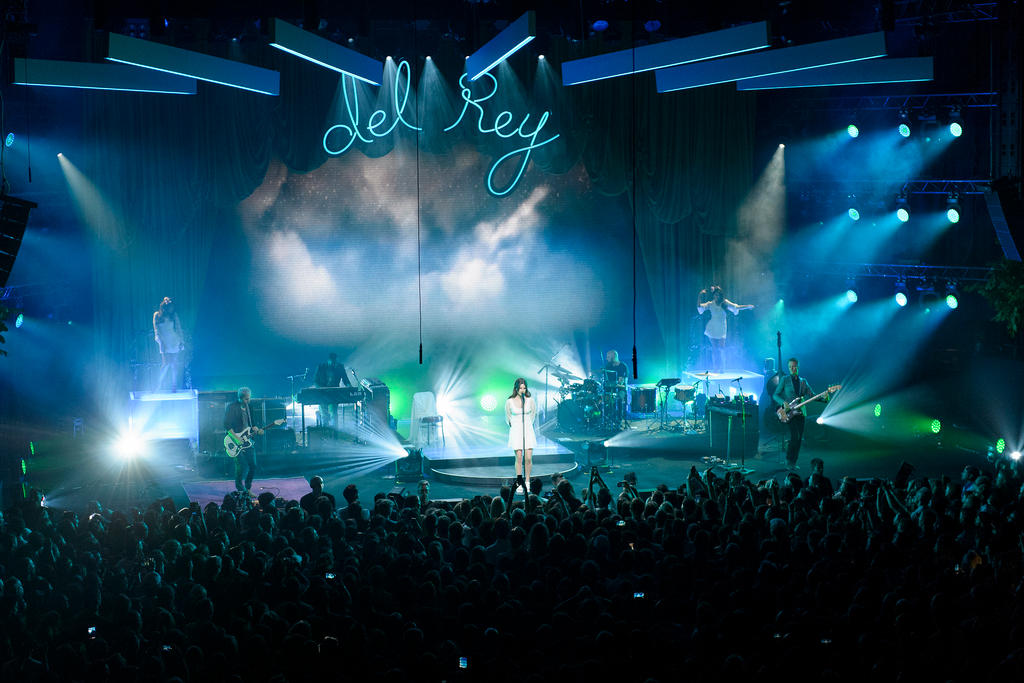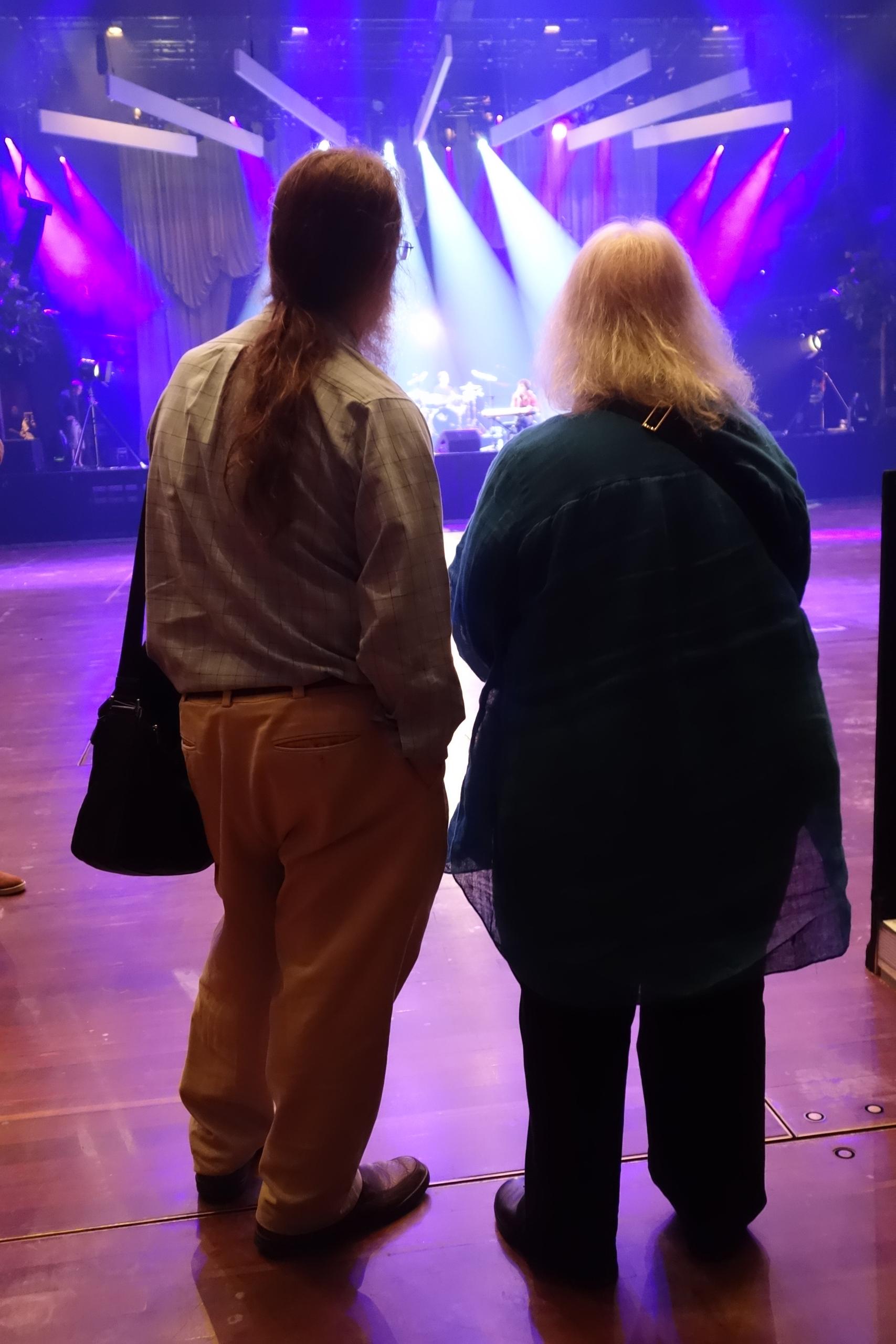
Montreux’s sonic wizards

Sporting a pony tail, straggly grey beard, long white hair and flowing robes, John and Helen Meyer have a certain mystical air about them. The co-owners of Meyer Sound, in charge of the sound of the Montreux Jazz Festival, have been working their magic on festival-goers for the past 30 years.
Standing in the middle of the empty 4,000-capacity Stravinski Hall, the main concert room, the Meyers listen intently as Max Jury and his band, tonight’s warm-up artist for pop superstar Lana Del Rey, do their sound check.
“The sound was punchy and loud and clear and you could hear every word which was good,” says Helen with a smile.
John, dressed in green-and black checked lumber jacket and chinos, fixes the stage, quietly scratching his chin. At the mixing desk at the back of the room, technicians adjust the levels of the Meyer top-of-the-range Lyon sound system. These are huge banks of line-array speakers hanging either side of the stage as well as subwoofers and other speakers dotted around the room.
“The quality is very high. It’s designed to be very powerful from a dynamic perspective. You can have loud levels and feel the peaks but without it being painful,” says John. “It’s a very pure sound with clarity and a directional aspect so you can design and focus the sound.”

Dead Heads
Since 1986 the Meyers, who come from Berkeley, California, have been transforming the acoustics at the Montreux Jazz Festival via their latest high-end equipment, which is considered by many as the gold standard in audio engineering. The couple regularly work with artists from Metallica to Justin Bieber, and have installed systems in dozens of places from LA film studios to Vienna’s Musikverein concert hall.
Chief sound guru John Meyer was born in Oakland in 1943 and grew up surrounded by music. His parents produced radio dramas. In the late sixties he worked in a Berkeley hi-fi store and one of his clients was Steve “Fly Like an Eagle” Miller, for whom he built a customised amplifier.
At that time John met Helen, a Russian Studies student at the University of California and together they started their first professional audio company, Glyph, in 1969. John became friends with members of the Grateful Dead and helped play a role in developing their famous “Wall of Sound”.
In 1973, the Meyers moved to Switzerland. John had a job as director of the acoustics department of the Institute for Advanced Musical Studies in Montreux, making audio recordings and building powerful speakers for classical music. There they met Montreux’s founder, the late Claude Nobs, who was excited about what John was doing.
“When I was growing up it was about doing higher quality and pushing the envelope,” said John. “I came from the hi-fi and FM radio world, so I like that high dynamic range. But that wasn’t being done in the ‘70s. It was about getting the loudest sound possible. We wanted to do something different to make it hi-fi and interesting. It didn’t need to be super loud and run at full power. This was a really new idea at the time.”
Forceful Claude Nobs

In the seventies, bands and engineers built different sound systems for different styles of music – one for classical, one for rock and roll and another for jazz.
“I always thought we should do something more universal,” said John.
He eventually built a prototype classical music speaker for Nobs that was tested in the former Congress Hall in Montreux.
“Claude didn’t need much convincing,” said Helen. “Once he recognised the technology was the most far out he made it happen and we went along with it. Claude was right on it. He knew what he wanted.”
But their collaboration didn’t start immediately. In 1975 the couple returned to California and started a new company, Meyer Sound, four years later. They stayed in touch with Nobs, but it took ten years before they were back in Switzerland in 1986.
Initially, the local tourist office, which partly funded the festival, was not convinced by the benefits of such a high-end sound system.
“I told them you’d get lots of young visitors, but they argued that kids wouldn’t be paying to stay in the hotels,” said John.
In the end it was Nobs’ forceful character that won them over.
“One day he just brought the new speakers in and said this is what we’re going to do now and pushed it through. People went along with it as he had a strong personality,” said Helen. “Claude was a very special person. He had an incredible sense of what to do, even if he didn’t know all the practical steps. He had a vision. He and John clicked as John had the technical vision and Claude the creative vision.”
Acoustic challenges
This year Muse, Herbie Hancock and Neil Young are just a few of the stars gracing the Stravinski stage and putting the Meyer speakers through their paces. Over 500 Meyer loudspeakers are also fitted in other Montreux clubs, bars and venues.
For the French pop group Air, which played on the Stravinski stage on July 1, Montreux is a favourite venue for musicians, especially because of the sound.
“Often it’s a real mess, but there it’s as if you are in the studio. The sound quality is impeccable,” they told the Le Matin Dimanche newspaper in an interview.
The California duo are more critical, however. They say Montreux’s halls are not particularly well designed inside for concerts.
“The Casino was pretty tough with low ceilings,” explains John. “Before they remodelled the Stravinski it was reverberating in a different way. We had to help them design the heavy sound curtains and put black thick things on the ceiling to absorb the sound.”
Helen is more forthright: “The fact that we make these rooms sound so good is a testament is what we can do. These rooms by themselves are not good.”
Despite these sonic issues, the Meyers say they feel intimately connected to the festival and Switzerland, which they visit very year to tweak and install new equipment.
“Our daughter was born here when we lived here. We love coming back and we love the creativity and spirit of the festival,” says Helen.

In compliance with the JTI standards
More: SWI swissinfo.ch certified by the Journalism Trust Initiative





























You can find an overview of ongoing debates with our journalists here . Please join us!
If you want to start a conversation about a topic raised in this article or want to report factual errors, email us at english@swissinfo.ch.